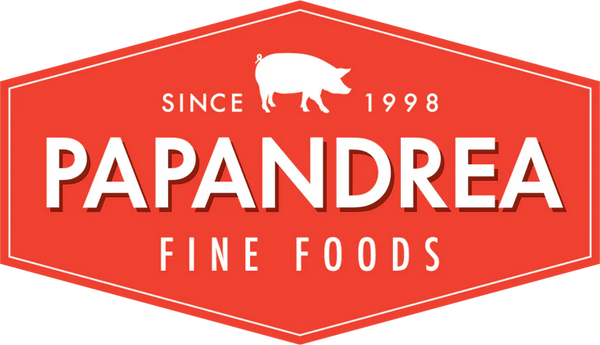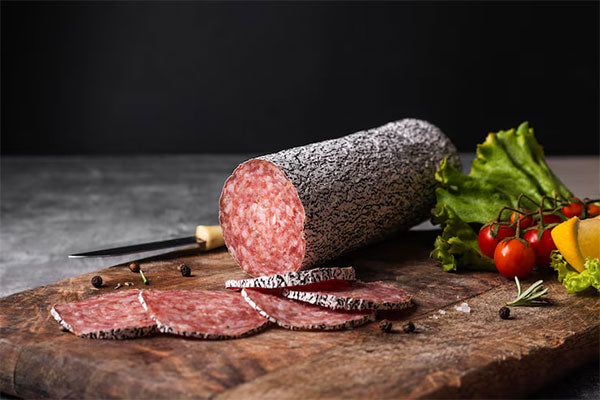Salami is one of Italy’s most celebrated culinary creations, renowned for its bold flavours, artisanal craftsmanship, and centuries-old traditions. Whether enjoyed on its own, in a sandwich, or as part of a charcuterie board, salami embodies the heritage of Italian food culture. But where does salami come from, and how has it evolved over time? At Papandrea, we honour the time-honoured techniques of Italian salami-making to bring you premium-quality cured meats. Let’s explore the fascinating origins of salami and its journey through history.
What is Salami?
Salami is a type of cured sausage made from ground pork, seasoned with salt, spices, and sometimes wine, then encased and left to ferment and dry. This process not only enhances its flavour but also preserves the meat, making it a staple in Italian households for centuries.
Different regions of Italy have developed their own unique styles of salami, influenced by local ingredients, climate, and culinary traditions. From the finely ground Salame Milano to the bold and spicy Salame Napoli, each variety tells a story of its regional heritage.
Ancient Origins: How Salami Was First Made
The origins of salami can be traced back thousands of years. Historians believe that the concept of curing and preserving meat dates as far back as the Roman Empire, where soldiers and travellers needed a reliable food source that could last for long journeys.
-
Roman Influence: Ancient Romans mastered the art of preserving meats using salt, a technique they learned from earlier civilizations like the Greeks and Phoenicians. The Latin word salumen, meaning "salted meats," is thought to be the root of the modern term "salami."
-
Medieval Italy: During the Middle Ages, Italian farmers and butchers refined the process, using regional spices and herbs to create distinct variations of salami. This period saw the rise of family-owned salumerias (delicatessens) that specialised in handcrafted cured meats.
By the Renaissance era, salami had become a prized delicacy, enjoyed by nobility and commoners alike. Its ability to be stored for long periods without refrigeration made it an essential part of Italian cuisine.
Regional Differences in Italian Salami
One of the most remarkable aspects of salami is its regional diversity. Each area of Italy has developed its own version, reflecting local tastes and traditions. Here are some of the most famous types of Italian salami:
1. Salame Milano (Lombardy)
- A finely ground, mild salami made with a blend of pork and subtle spices.
- Known for its smooth texture and delicate flavour, making it ideal for sandwiches and antipasto platters.
2. Salame Napoli (Campania)
- A coarser, spicier salami with bold black pepper and garlic flavours.
- Traditionally aged longer for a more intense, rich taste.
3. Finocchiona (Tuscany)
- Infused with fennel seeds, giving it a slightly sweet, aromatic profile.
- Pairs beautifully with crusty bread and a glass of Chianti wine.
4. ‘Nduja (Calabria)
- A spreadable, fiery salami made with pork and Calabrian chilies.
- Perfect for spreading on toast, stirring into pasta, or adding to pizzas for a spicy kick.
Each of these varieties showcases the artistry of Italian salami-making and the distinct regional flavours that have made it a worldwide favourite.
The Role of Salami in Italian Cuisine
Over the centuries, salami has remained a central ingredient in Italian cooking. It is often featured in:
- Antipasto Platters: Served with cheeses, olives, and bread as a classic Italian appetiser.
- Panini and Sandwiches: Adds rich, savoury depth to Italian-style sandwiches.
- Pasta Dishes: Some salami varieties, like ’nduja, are used to enhance pasta sauces with smoky, spicy flavours.
- Charcuterie Boards: A staple of gourmet entertaining, paired with wine and accompaniments.
The versatility of salami makes it an essential part of both everyday meals and special occasions.
How Salami is Made Today
At Papandrea, we honour the traditions of Italian salami-making while using modern techniques to ensure the highest quality. The process remains true to its roots:
- Selection of the Finest Ingredients – We use premium cuts of pork, seasoned with carefully selected spices.
- Fermentation & Drying – Our salami undergoes a natural fermentation process, enhancing its complex flavours.
- Aging & Maturation – Each type of salami is aged for the perfect length of time to develop its signature taste and texture.
By preserving traditional methods, we ensure that every bite of our salami delivers an authentic taste of Italy.
Experience Authentic Italian Salami with Papandrea
If you're looking for the finest Italian salami, Papandrea offers a selection crafted with passion and expertise. Whether you prefer the mild elegance of Salame Milano or the bold heat of ’nduja, our range caters to every palate.
Visit our website to explore our collection and bring the authentic taste of Italy into your home. Experience the rich history and tradition of salami—one slice at a time.

